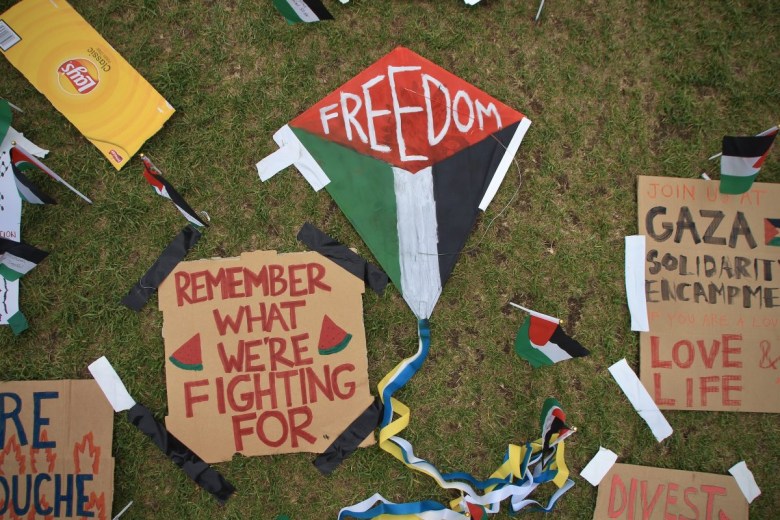On Tuesday morning, April 23, less than a week after more than 100 Columbia University students were suspended and arrested for protesting on university grounds, 11 members of the arts faculty sent their students a letter.
“We, the undersigned Visual Arts and Music faculty, stand for your constitutional rights of assembly and free speech. We ask the University to revoke all suspensions, expunge the disciplinary records of sanctioned students, and immediately allow all students back into their dormitories,” the letter said.
“You are the essence of the University. Your education is our only priority and fighting for that when necessary is our highest responsibility.”
They weren’t the only arts faculty showing support amid the protests on college campuses across the country, where students are setting up “Gaza Solidarity Encampments” and refusing to leave until their demands are met — namely, financial transparency around and divestment from corporations and institutions tied to the Israeli occupation and attacks on Palestine.


The campus demonstrations have been overwhelmingly peaceful, even serene. Students spend their days sitting, reading, studying on the lawns, and gathering for poetry readings, chants, dances, and prayer. On Monday evening just before sundown, Jewish students at the Columbia encampment gathered together to observe a Seder for Passover. While isolated incidents of violence were reported across the city, they were distinct from the campus encampments. A Bachelor of Arts candidate at the New School who requested anonymity fondly remembers one of the most moving moments from the protest, when a faculty member who is a cello player performed the Palestinian national anthem. At Columbia, students set up an “art corner” on the north end of the occupied lawn covered with posters, paintings, and tiny Palestinian flags — each one with the name of a person killed in Gaza.


“My impression was that there was a sincere commitment to the relationship between politics and art, and also art and life,” said Matthew Buckingham, department chair and professor of Visual Arts at Columbia University. He was part of the massive faculty walkout on Monday, with over 100 professors and other staffers voicing their opposition to student suspensions and arrests.
Among the outside groups showing support for students were members of the Strike MoMA campaign, which staged a series of protests at the Museum of Modern Art in 2021 aiming to expose museum trustees’ complicity in global human rights violations, including in Palestine.
“The people that sit on these institutions’ boards and control them are the same people who profit from war, death, and destruction, and in this case specifically the killing of over 40,000 Palestinians so far since October 7,” members of the coalition told Hyperallergic.


Ash Moniz, a student of fine arts at Parsons School of Design, part of the New School, observed a tension between universities’ push for socially engaged work and its actions toward students in the past week.
“Your art is more valuable the more political it is. There is a historical relationship between art and social change, but the capitalist system has hijacked that historical moment,” Moniz said. “This capital shapes the market in a way that encourages students to embody a type of radicality that the market prefers, rather than the type of radicality that has influenced social change throughout history.”
Fields Harrington, a member of the fine arts faculty at the New School, echoed those sentiments.
“With artists only being concerned about their practice and not centering Gaza, and deciding not to speak out about Palestine because of how it may impact their career, I’ve been saying to myself, ‘Well if that’s the case, then politics and art is equivalent to oil and water,’” Harrington said. “You can see the oil and the water but they don’t shift or pivot anything. They don’t radically change anything.”
An artist and alumnus of New York University (NYU), Zayira Ray, found the visuals of the arrests that took place on campus incredibly sinister.
“As an artist, I think the idea of a wall and a blockade, physically, metaphorically, and symbolically, is ironic,” she told Hyperallergic, referring to the plywood blockade that the university administration erected around Gould Plaza soon after the arrests. “It is ironic of NYU to put up a physical blockade to suppress voices that are against occupations and blockades.”

In response to the student protests at Columbia, the administration on Monday announced hybrid classes for the rest of the year amid calls for tuition refunds. The university’s commencement is scheduled for May 15, and there are questions among the student body about whether it will take place at all. As negotiations between the school administration and protesters began on the night of Tuesday, April 23, students and faculty filled the entire turnout of the university campus, but talks stopped after student representatives claimed that the administration threatened to call the National Guard to disperse the protests.
The same night, Columbia President Nemat (Minouche) Shafik sent the student body an email: “I very much hope these discussions are successful. If they are not, we will have to consider alternative options for clearing the West Lawn and restoring calm to campus so that students can complete the term and graduate.”
The university administration did not respond to a request for comment.
“Many people say that art can’t be taught, and I actually do believe that teaching art is about creating an environment within which to ask questions,” said Buckingham. “This is something I hoped I would never see at Columbia or any other institution, and I was feeling very fearful for the students’ well-being. It felt like a corner I really hoped we would never turn.”

